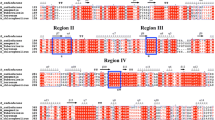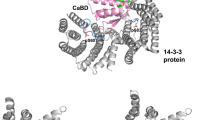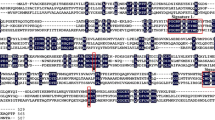Abstract
Two archaeal trehalase-like genes, Saci1250 and Saci1816, belonging to glycoside hydrolase family 15 (GH15) from the acidophilic Crenarchaeon Sulfolobus acidocaldarius were expressed in Escherichia coli. The gene products showed trehalose-hydrolyzing activities, and the names SaTreH1 and SaTreH2 were assigned to Saci1816 and Saci1250 gene products, respectively. These newly identified enzymes functioned within a narrow range of acidic pH values at elevated temperatures, which is similar to the behavior of Euryarchaeota Thermoplasma trehalases. SaTreH1 displayed high KM and kcat values, whereas SaTreH2 had lower KM and kcat values despite a high degree of identity in their primary structures. A mutation analysis indicated that two glutamic acid residues in SaTreH1, E374 and E574, may be involved in trehalase catalysis because SaTreH1 E374Q and E574Q showed greatly reduced trehalose-hydrolyzing activities. Additional mutations substituting G573 and H575 residues with serine and glutamic acid residues, respectively, to mimic the TVN1315 sequence resulted in a decrease in trehalase activity and thermal stability. Taken together, the results indicated that Crenarchaea trehalases adopt active site structures that are similar to Euryarchaeota enzymes but have distinct molecular features. The identification of these trehalases could extend our understanding of the relationships between the structure and function of GH15 trehalases as well as other family enzymes and will provide insights into archaeal trehalose metabolism.






Similar content being viewed by others
References
Alblova M, Smidova A, Docekal V, Vesely J, Herman P, Obsilova V, Obsil T (2017) Molecular basis of the 14-3-3 protein-dependent activation of yeast neutral trehalase Nth1. Proc Natl Acad Sci U S A 114:E9811–E9820. https://doi.org/10.1073/pnas.1714491114
Aleshin AE, Feng PH, Honzatko RB, Reilly PJ (2003) Crystal structure and evolution of a prokaryotic glucoamylase. J Mol Biol 327:61–73. https://doi.org/10.1016/S0022-2836(03)00084-6
App H, Holzer H (1989) Purification and characterization of neutral trehalase from the yeast ABYS1 mutant. J Biol Chem 264:17583–17588
Argüelles JC (2000) Physiological roles of trehalose in bacteria and yeasts: a comparative analysis. Arch Microbiol 174:217–124. https://doi.org/10.1007/s002030000192
Barraza A, Sánchez F (2013) Trehalases: a neglected carbon metabolism regulator? Plant Signal Behav 8:e24778. https://doi.org/10.4161/psb.24778
Carroll JD, Pastuszak I, Edavana VK, Pan YT, Elbein AD (2007) A novel trehalase from Mycobacterium smegmatis—purification, properties, requirements. FEBS J 274:1701–1714. https://doi.org/10.1111/j.1742-4658.2007.05715.x
DeBosch BJ, Heitmeier MR, Mayer AL, Higgins CB, Crowley JR, Kraft TE, Chi M, Newberry EP, Chen Z, Finck BN, Davidson NO, Yarasheski KE, Hruz PW, Moley KH (2016) Trehalose inhibits solute carrier 2A (SLC2A) proteins to induce autophagy and prevent hepatic steatosis. Sci Signal 9:ra21. https://doi.org/10.1126/scisignal.aac5472
Elbein AD, Pan YT, Pastuszak I, Carroll D (2003) New insights on trehalose: a multifunctional molecule. Glycobiology 13:17–27. https://doi.org/10.1093/glycob/cwg047
Franco A, Soto T, Vicente-Soler J, Paredes V, Madrid M, Gacto M, Cansado J (2003) A role for calcium in the regulation of neutral trehalase activity in the fission yeast Schizosaccharomyces pombe. Biochem J 376:209–217. https://doi.org/10.1042/bj20030825
Higashiyama T (2002) Novel functions and applications of trehalose. Pure Appl Chem 74:1263–1269. https://doi.org/10.1351/pac200274071263
Horlacher R, Uhland K, Klein W, Ehrmann M, Boos W (1996) Characterization of a cytoplasmic trehalase of Escherichia coli. J Bacteriol 178:6250–6257. https://doi.org/10.1128/jb.178.21.6250-6257.1996
Iakoucheva LM, Radivojac P, Brown CJ, O’Connor TR, Sikes JG, Obradovic Z, Dunker AK (2004) The importance of intrinsic disorder for protein phosphorylation. Nucleic Acids Res 32:1037–1049. https://doi.org/10.1093/nar/gkh253
Iturriaga G, Suárez R, Nova-Franco B (2009) Trehalose metabolism: from osmoprotection to signaling. Int J Mol Sci 10:3793–3810. https://doi.org/10.3390/ijms10093793
Jules M, Beltran G, François J, Parrou JL (2008) New insights into trehalose metabolism by Saccharomyces cerevisiae: NTH2 encodes a functional cytosolic trehalase, and deletion of TPS1 reveals Ath1p-dependent trehalose mobilization. Appl Environ Microbiol 74:605–614. https://doi.org/10.1128/AEM.00557-07
Kennelly PJ (2014) Protein Ser/Thr/Tyr phosphorylation in the archaea. J Biol Chem 289:9480–9487. https://doi.org/10.1074/jbc.R113.529412
Kopecka M, Kosek D, Kukacka Z, Rezabkova L, Man P, Novak P, Obsil T, Obsilova V (2014) Role of the EF-hand-like motif in the 14-3-3 protein-mediated activation of yeast neutral trehalase Nth1. J Biol Chem 289:13948–13961. https://doi.org/10.1074/jbc.M113.544551
Kumar S, Stecher G, Tamura K (2016) MEGA7: molecular evolutionary genetics analysis version 7.0 for bigger datasets. Mol Biol Evol 33:1870–1874. https://doi.org/10.1093/molbev/msw054
Laemmli UK (1970) Cleavage of structural proteins during the assembly of the head of bacteriophage T4. Nature 227:680–685. https://doi.org/10.1038/227680a0
Li Z, Wei P, Cheng H, He P, Wang Q, Jiang N (2014) Functional role of β-domain in the Thermoanaerobacter tengcongensis glucoamylase. Appl Microbiol Biotechnol 98:2091–2099. https://doi.org/10.1007/s00253-013-5051-2
Maicas S, Guirao-Abad JP, Argüelles JC (2016) Yeast trehalases: two enzymes, one catalytic mission. Biochim Biophys Acta 1860:2249–2254. https://doi.org/10.1016/j.bbagen.2016.04.020
Martins LO, Huber R, Huber H, Stetter KO, Da Costa MS, Santos H (1997) Organic solutes in hyperthermophilic archaea. Appl Environ Microbiol 63:896–902
Mertens JA, Braker JD, Jordan DB (2010) Catalytic properties of two Rhizopus oryzae 99-880 glucoamylase enzymes without starch binding domains expressed in Pichia pastoris. Appl Biochem Biotechnol 162:2197–2213. https://doi.org/10.1007/s12010-010-8994-0
Mittenbühler K, Holzer H (1988) Purification and characterization of acid trehalase from the yeast suc2 mutant. J Biol Chem 263:8537–8543
Moon JH, Lee W, Park J, Choi KH, Cha J (2016) Characterization of a trehalose-degrading enzyme from the hyperthermophilic archaeon Sulfolobus acidocaldarius. J Biosci Bioeng 122:47–51. https://doi.org/10.1016/j.jbiosc.2015.12.011
Niesen FH, Berglund H, Vedadi M (2007) The use of differential scanning fluorimetry to detect ligand interactions that promote protein stability. Nat Protoc 2:2212–2221. https://doi.org/10.1038/nprot.2007.321
Okawa K, Ohno M, Kashimura A, Kimura M, Kobayashi Y, Sakaguchi M, Sugahara Y, Kamaya M, Kino Y, Bauer PO, Oyama F (2016) Loss and gain of human acidic mammalian chitinase activity by nonsynonymous SNPs. Mol Biol Evol 33:3183–3193. https://doi.org/10.1093/molbev/msw198
Ortiz CH, Maia JC, Tenan MN, Braz-Padrão GR, Mattoon JR, Panek AD (1983) Regulation of yeast trehalase by a monocyclic, cyclic AMP-dependent phosphorylation-dephosphorylation cascade system. J Bacteriol 153:644–651
Panni S, Landgraf C, Volkmer-Engert R, Cesareni G, Castagnoli L (2008) Role of 14-3-3 proteins in the regulation of neutral trehalase in the yeast Saccharomyces cerevisiae. FEMS Yeast Res 8:53–63. https://doi.org/10.1111/j.1567-1364.2007.00312.x
Sakaguchi M, Matsushima Y, Nankumo T, Seino J, Miyakawa S, Honda S, Sugahara Y, Oyama F, Kawakita M (2014) Glucoamylase of Caulobacter crescentus CB15: cloning and expression in Escherichia coli and functional identification. AMB Express 4:5. https://doi.org/10.1186/2191-0855-4-5
Sakaguchi M, Shimodaira S, Ishida S, Amemiya M, Honda S, Sugahara Y, Oyama F, Kawakita M (2015) Identification of GH15 family thermophilic archaeal trehalases that function within a narrow acidic pH range. Appl Environ Microbiol 81:4920–4931. https://doi.org/10.1128/AEM.00956-15
Sakaguchi M, Matsushima Y, Nagamine Y, Matsuhashi T, Honda S, Okuda S, Ohno M, Sugahara Y, Shin Y, Oyama F, Kawakita M (2017) Functional dissection of the N-terminal sequence of Clostridium sp. G0005 glucoamylase: identification of components critical for folding the catalytic domain and for constructing the active site structure. Appl Microbiol Biotechnol 101:2415–2425. https://doi.org/10.1007/s00253-016-8024-4
Sarkar S, Davies JE, Huang Z, Tunnacliffe A, Rubinsztein DC (2007) Trehalose, a novel mTOR independent autophagy enhancer, accelerates the clearance of mutant huntingtin and α-synuclein. J Biol Chem 282:5641–5652. https://doi.org/10.1074/jbc.M609532200
Shirai A, Matsuyama A, Yashiroda Y, Hashimoto A, Kawamura Y, Arai R, Komatsu Y, Sueharu Horinouchi, Minoru Yoshida, (2008) Global analysis of gel mobility of proteins and its use in target identification. J Biol Chem 283(16):10745–10752
Tourinho-dos-Santos CF, Bachinski N, Paschoalin VM, Paiva CL, Silva JT, Panek AD (1994) Periplasmic trehalase from Escherichia coli: characterization and immobilization on spherisorb. Braz J Med Biol Res 27:627–636
Uno I, Matsumoto K, Adachi K, Ishikawa T (1983) Genetic and biochemical evidence that trehalase is a substrate of cAMP-dependent protein kinase in yeast. J Biol Chem 258:10867–10872
Veisova D, Macakova E, Rezabkova L, Sulc M, Vacha P, Sychrova H, Obsil T, Obsilova V (2012) Role of individual phosphorylation sites for the 14-3-3-protein-dependent activation of yeast neutral trehalase Nth1. Biochem J 443:663–670. https://doi.org/10.1042/BJ20111615
Acknowledgements
We are grateful to Yukari Saisaka (High-Tech Research Center, Meiji Pharmaceutical University) for performing the N-terminal sequence analysis and Misa Ohno, Kazuaki Okawa, and Satoshi Wakita for their valuable suggestions.
Funding
This study was supported by the Japan Society for the Promotion of Science (JSPS) KAKENHI (Grant Number 17 K07729); the Strategic Research Foundation Grant-aided Project for Private Universities of the Ministry of Education, Culture, Sport, Science, and Technology, Japan (MEXT) (Grant Number S1411005); the Science Research Promotion Fund from the Promotion and Mutual Aid Corporation for Private Schools of Japan; and the Project Research Grant from the Research Institute of Science and Technology, Kogakuin University.
Author information
Authors and Affiliations
Corresponding author
Ethics declarations
Conflict of interest
The authors declare that they have no conflict of interest.
Ethical approval
This article does not contain any studies with human participants or animals.
Electronic supplementary material
ESM 1
(PDF 267 kb)
Rights and permissions
About this article
Cite this article
Yuasa, M., Okamura, T., Kimura, M. et al. Two trehalose-hydrolyzing enzymes from Crenarchaeon Sulfolobus acidocaldarius exhibit distinct activities and affinities toward trehalose. Appl Microbiol Biotechnol 102, 4445–4455 (2018). https://doi.org/10.1007/s00253-018-8915-7
Received:
Revised:
Accepted:
Published:
Issue Date:
DOI: https://doi.org/10.1007/s00253-018-8915-7




